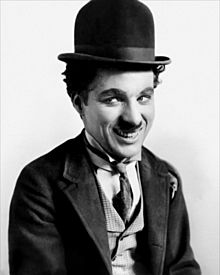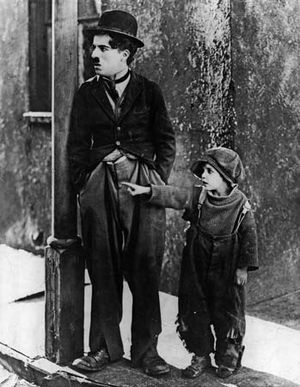The Tramp facts for kids
Quick facts for kids The Tramp |
|
|---|---|

Charlie Chaplin in costume as his signature character the Tramp
|
|
| First appearance | Kid Auto Races at Venice (1914) |
| Last appearance | Modern Times (1936) |
| Created by | Charlie Chaplin |
| Portrayed by | Charlie Chaplin |
| Information | |
| Aliases |
|
| Occupation | Tramp |
| Title | The Little Fellow |
| Children | Kid ("John") (surrogate son) |
| Religion | Christianity |
| Nationality | British |
The Tramp (also known as the Little Tramp) was a famous movie character. He was created and played by the English actor Charlie Chaplin. The Tramp became a huge icon in movies, especially during the time of silent films. The Tramp is also the name of a silent film from 1915, which Chaplin wrote and directed.
Chaplin played the Tramp as a kind, but often clumsy, character. He was usually a homeless person who tried to act like a gentleman. Even though he was poor, he always tried to keep his dignity. The Tramp was clever and found ways to survive. He often had to escape from people in charge who didn't like his silly actions. Chaplin sometimes called him "The little fellow."
Contents
How the Tramp Character Started
The Tramp character was actually created by accident! Charlie Chaplin was working at Mack Sennett's Keystone Studios in 1914. He was getting ready for a short film called Mabel's Strange Predicament.
In an interview, Chaplin explained how he came up with the Tramp's look. He needed a funny costume quickly. So, he went to the wardrobe department. He grabbed some baggy pants, a tight coat, a small derby hat, and big shoes. He wanted his clothes to look mismatched and funny. To add a comic touch, he wore a small mustache. This mustache didn't hide his expressions. Everyone loved his new look, including the studio boss, Mr. Sennett. Chaplin felt that the clothes helped him understand the character. He said the Tramp became "a man with a soul—a point of view."
The first film where the Tramp costume was used was Mabel's Strange Predicament. But another film, Kid Auto Races at Venice, was released two days earlier. So, Kid Auto Races at Venice (released February 7, 1914) was the first time the public saw the Tramp. Chaplin and his Little Tramp character quickly became very popular. He played the Tramp in many short films and later in longer movies.
The Tramp was strongly connected to the silent film era. He was known all over the world. In 1931, Chaplin made City Lights, which had no talking. Chaplin officially stopped playing the Tramp in the movie Modern Times (1936). This film ended with the Tramp walking away into the distance. Modern Times was mostly silent, but near the end, the Tramp's voice was heard for the first time. He sang a funny, made-up song.
In The Great Dictator, Chaplin played two roles. One was a dictator like Hitler, and the other was a Jewish barber. Chaplin said the barber was not the Tramp. However, the barber looked very similar, with the same mustache and hat. Even though the barber spoke throughout the film, he still had some silent scenes.
Years later, in 1959, Chaplin said he was wrong to stop playing the Tramp. He felt there was still a place for "the Little Man" in the modern world.
What the Tramp Looked Like
The Tramp had a very specific look. He wore:
- Baggy pants
- A tight coat
- A bowler hat
- Large shoes
- A flexible cane
- A small "toothbrush" mustache
Chaplin wanted these items to look like a mix of different things. This made the character visually interesting and funny.
The films The Tramp and The Bank (both from 1915) really helped define his character. The Tramp often faced disappointment, especially in love. But he would always shake it off and go back to his carefree ways.
The Tramp was often caught in difficult situations. Sometimes, things worked out for him by accident. For example, in Modern Times, he picks up a red flag that falls from a truck. He waves it to return it, but accidentally becomes the leader of a protest! This lands him in jail. While in jail, he helps stop some prisoners from escaping. The warden offers to let him go, but the Tramp prefers to stay in jail. He thinks it's better than the outside world.
Why the Tramp Was Important
Chaplin's films often showed his thoughts on society. He criticized the problems caused by factories and new technologies. But he also showed hope for the "American Dream." In Modern Times, Chaplin showed how wealthy business leaders lived. He also showed the struggles of workers in the 1930s.
For example, the Tramp and other workers sweat on an assembly line. Meanwhile, the company president plays puzzles and reads comics. The focus on working fast and efficiently eventually drives the Tramp crazy. This can be seen as a criticism of how factories were run. However, the film also showed a positive view of the American middle class.
One scene shows the Tramp dreaming of a normal middle-class life. He and a young girl find a small shack to live in. The girl cooks a simple breakfast. Then, the Tramp goes to work, and the girl stays home to take care of things. This showed a typical middle-class family setting. At the end of Modern Times, the film still gives a hopeful message. The girl says, "What's the use of trying?" And the Tramp replies, "Buck up—never say die." Chaplin was unique in using his silent films to share his ideas about society.
In The Great Dictator (1940), Chaplin played two characters who looked like the Tramp. This was Chaplin's first movie with talking. The film was inspired by how similar Chaplin's Tramp mustache looked to Adolf Hitler's. Chaplin used this similarity to create a dark, funny version of the dictator. Chaplin later said he didn't know about the Holocaust when he made the film. If he had, he wouldn't have made it a comedy.
Films Featuring the Tramp
The Tramp appeared in many films across different studios. Here are some of the most notable ones:
Keystone Films
Charlie Chaplin made 36 films for Keystone Studios. The Tramp character appeared in 25 of them. Most were short, one-reel films.
- Kid Auto Races at Venice (1914) – The first film released with the Tramp.
- Mabel's Strange Predicament (1914) – The first film where the Tramp costume was used.
- The Property Man (1914) – A two-reel film.
- Dough and Dynamite (1914) – A two-reel film.
Essanay Films
Chaplin wrote, directed, and starred in 15 films for the Essanay Film Manufacturing Company. The Tramp appeared in 13 of these. Most were two-reel films.
- His New Job (1915)
- The Champion (1915)
- The Tramp (1915) – A very important film for the character.
- The Bank (1915)
Mutual Films
Chaplin wrote, produced, directed, and starred in 12 films for the Mutual Film Corporation. Most of these films featured Chaplin dressed as the Tramp. All Mutual films were two reels long.
- The Floorwalker (1916)
- The Vagabond (1916)
- The Pawnshop (1916)
- Easy Street (1917)
- The Immigrant (1917) – Added to the National Film Registry in 1998.
First National Films
Chaplin made nine films for his own company, distributed by First National. The Tramp appeared in most of these.
- A Dog's Life (1918)
- Shoulder Arms (1918)
- The Kid (1921) – A very famous six-reel film. Added to the National Film Registry in 2011.
- Pay Day (1922) – Chaplin's last short film.
United Artists Films
Chaplin made eight films for United Artists. Four of these featured the Tramp character. Chaplin also wrote the music for these films.
- The Gold Rush (1925) – Added to the National Film Registry in 1992.
- The Circus (1928)
- City Lights (1931) – A silent film with music. Added to the National Film Registry in 1991.
- Modern Times (1936) – The last film featuring the Tramp. Added to the National Film Registry in 1989.
- The Great Dictator (1940) – While not officially a Tramp film, the barber character looks very similar.
People Who Imitated the Tramp
Because Chaplin's Tramp was so popular, many people tried to copy the character. This happened a lot in the 1910s. Even after that, people continued to imitate the Tramp because they admired Chaplin. Some animated films also featured a silent character like the Tramp.
The most famous person to imitate the Tramp was Billy West. He appeared in many films where he looked and acted like Chaplin's character.
The Tramp's Legacy
The Tramp character left a big mark on popular culture:
- In 1915, a song called "Those Charlie Chaplin Feet" was made about the Tramp.
- Walt Disney said that the Tramp helped inspire the character of Mickey Mouse. Disney wanted Mickey to have some of the Tramp's hopeful spirit.
- The Tramp is often seen as a symbol of the Great Depression.
- In the 1980s, the Tramp character was used in advertisements for the IBM PC computer.
- The cartoon character "Baggy Pants" is an imitation of the Tramp.
- From 1973 to 1990, the TV show Sesame Street sometimes featured a character dressed as the Tramp.
- Indian filmmaker-actor Raj Kapoor was inspired by the Tramp. He played similar characters in his films like Awaara (1951).
- In 2006, Premiere magazine listed Chaplin's performance as the Tramp in City Lights as one of the "100 Greatest Performances of all Time."
- The Tramp is the main character in the modern CGI TV series Chaplin & Co. This show places him in the 21st century.
- Homer Simpson dressed up as the Tramp in an episode of The Simpsons.
- The 1995 musical Little Tramp tells the story of Chaplin's life and how he created the Tramp.
See also
 In Spanish: Charlot para niños
In Spanish: Charlot para niños


